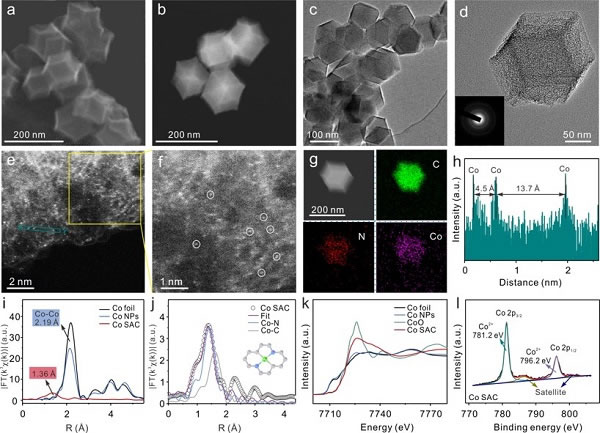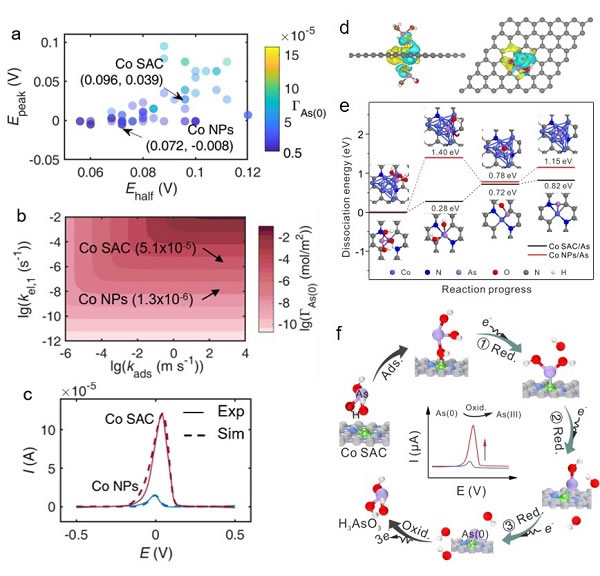Recently, a team of Huang Xingjiu, a researcher at the Institute of Intelligent Machinery of the Hefei Academy of Material Sciences, Chinese Academy of Sciences, and a professor at the University of Science and Technology of China, Zeng Jie, used the Co single atom catalyst (Co SAC) dispersed on nitrogen-doped porous carbon for the first time (III) Ultra-high sensitivity and selective electrochemical detection. At the same time, combined with the methods of synchrotron radiation X-ray absorption fine structure (XAFS) technology, density functional theory calculation (DFT) and kinetic simulation calculation, the interaction between Co SAC and H3AsO3 in the electrochemical analysis process was explored in detail from the perspective of electrocatalysis Function mode and working mechanism. Related results have been accepted for publication by Analytical Chemistry (DOI: 10.1021 / acs.analchem.0c00677).
In recent years, various nanomaterials such as precious metals, alloys, carbon materials, metal oxides and their composites have been widely used in the electrochemical analysis of As (III). However, most studies mainly rely on empirical testing, focusing only on electrochemical phenomena such as sensitivity, detection limit, and selectivity, and ignoring the corresponding detection mechanism. Therefore, we want to truly achieve high sensitivity and selection of As (III) in water Sex testing is still a huge challenge. In fact, the essence of electrochemical detection is the electrocatalytic reaction process at the sensing interface, which will affect the enrichment / reduction of As (III) and the corresponding dissolution / oxidation signal, but there is still a lack of science from the perspective of electrocatalysis understanding. Therefore, to explore the interaction between the sensing interface and the target analyte, and to clarify the corresponding electrocatalytic mechanism, is essential for the development of an effective functional sensing interface to achieve high sensitivity and selective detection of As (III).
Based on the above problems, the researchers first successfully synthesized the Co SAC catalyst and used it for the electrochemical detection of As (III), which can achieve an ultra-high sensitivity of 11.44 μA ppb-1 and excellent selectivity for As (III). This sensitivity is the highest among the currently reported non-precious metal catalysts, and even better than most precious metal nanomaterials. Combining the results of XAFS and DFT calculations, the researchers found that H3AsO3 molecules were catalytically activated by the Co-N2C2 active site during the reaction and formed Co-O hybrid bonds, which led to a decrease in the energy barrier of the As-O dissociation step during the reduction of H3AsO3. In addition, the reaction kinetics simulation calculations show that the first electron transfer process is the rate-limiting step of the entire H3AsO3 reduction, which is much faster on Co SAC than on Co nanoparticle materials (Co NPs), thereby promoting Rapid rapid mass deposition greatly enhances the electrochemical response signal of As (III). The selectivity for As (III) is also attributed to the formation of Co-O hybrid bonds because there is no specific interaction site between Co SAC and ordinary divalent heavy metal ions that do not contain oxygen anions.
This work is the first to use a single atom catalyst to construct a sensing interface for the electrochemical analysis of heavy metal ions, which expands the application of single atom catalyst in the field of electroanalysis. Through advanced XAFS characterization, DFT calculation and kinetic numerical simulation, it is possible to effectively link atoms and electronic structures with macroscopic electrochemical phenomena, indicating that the electrocatalytic capability of the sensing material is in the sensitive and selective detection of analytes It plays a vital role. The study of the working mechanism of Co SAC provides atomic-level catalytic insights and important theoretical guidance for the design of functional sensing interfaces in environmental applications. At the same time, it also provides inspiration for catalytic treatment and removal of such pollutants in the water environment.

Figure 1. Co SAC material morphology and structure characterization

Figure 2. a) -c) Kinetic numerical fitting; d), e) DFT calculation; f) Enhanced electrochemical detection mechanism diagram
Ground Screw is made of material Q235 and finished by hot dipped galvanized. They are widely used in foundation system for solar panal, fence, wooden house, advertising boards, flag pole and etc. They can be easily installed by spiral piling machine, no digging, no concrete, no waitting, much convenient,cost effective, time saving and environmentally than concete foundation.
Ground screw technology is known worldwide and eliminates the need for concrete footings.
They are installed much like a traditional screw which allows them to be set within minutes--not hours or days like concrete. Ground Screw Foundations can be used to secure almost anything into the ground--from solar lighting, road signs, and recreation equipment. Plus, they are suitable for a wide range of soil and ground types, are stable and long-lasting.
Advantages:
1.No excavating, digging, or concrete
2.Installs within minutes
3.Instantly loadable with no waiting time
4.Stable, durable, storm proof, water proof, and secure against wind
5.Environmentally friendly, ecological, and sustainable
6.No damage to surrounding landscape
7.Fast and inexpensive to dismantle and relocate
8.Can be installed into sealed surfaces
Type:
1.Anchor with flange
The end of part is welded with flange which is easy for connections. This type is usually used for buildings and wharf because of its high accuracy and stability.
2.Anchor with U plate
The end of part is weld with U shape plate, this kind of anchor has good performance in connection and easy for operation. Normally used for fence and barrier.
3.Anchor with nuts
This type of anchor is fixed by three or four nuts which means easy for installation. It`s insert length can be adjusted according to customer demands. Normally used for the base of solar panels.
Benefits:
1.Flexible and efficient: the ground screw can be used as a foundation for a variety of permanent or portable ground mounted applications, from single highway signs, to fencing and large scale solar farms.
2.Unbeatable construction times, with top precision: the ground screw is installed using a number of different aids and machinery. It is driven into the ground at the exact point in a matter of minutes
3.Concrete-free innovation: no digging, excavation, wet trades, or curing time, which means no wait, and no delays!
4.Sustainable, cost-effective alternative to traditional foundations: The Honde ground screw is made from 75-80 per cent recycled steel. Ground screw installation is a low impact, vibration free process, as well as being completely and easily removable. Installation and removal have minimum impact on the landscape
5.Safe, robust, and uncomplicated: our ground screws have been stringently tested and gained European wide compliance through TUV Reinland and ISO1461 certification
6.Highways approved in the UK: our ground screw has been approved for use within highways, including passively safe supports and accepted by the Highways Agency for use on motorways and trunk roads. It has also been approved by the German Federal Road & Transport Authorities for the erection of all types of traffic and directional signs
6.Proven technology in renewable energy: the ground screw foundation has been used for over 10 years across Europe to install over 800MWp of solar PV programmes and supports over 10 per cent of the world market. In the UK, during 2011 and 2012, our ground screw was the chosen foundation for the construction of some of the UK`s largest solar farms, as well a large number of other schemes
7.Long-lasting, with consistent and reliable performance: our ground screw provides a guarantee of 20 years and have been successfully tested to 30 years` lifetime in the ground, with an overall life span of up to 50 years.
Ground Screw
Ground Screw,Ground Screw Post Anchor,Helical Screw Piles,No Dig Ground Screw
Hebei Honde Plastic & Metal Co., Ltd. , https://www.foundation-system.com